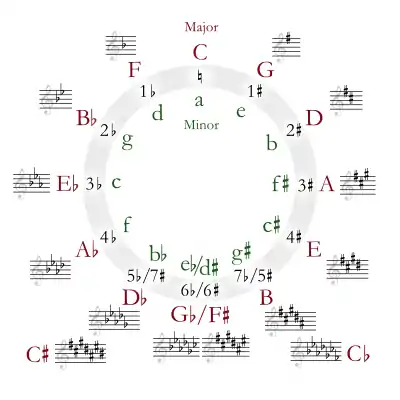G minor
G minor is a minor scale based on G, consisting of the pitches G, A, B♭, C, D, E♭, and F. Its key signature has two flats. Its relative major is B-flat major and its parallel major is G major.
| Relative key | B-flat major |
|---|---|
| Parallel key | G major |
| Dominant key | D minor |
| Subdominant | C minor |
| Component pitches | |
| G, A, B♭, C, D, E♭, F | |
The G natural minor scale is:
Changes needed for the melodic and harmonic versions of the scale are written in with accidentals as necessary. The G harmonic minor and melodic minor scales are:
Scale Degree Chords
- Tonic - G minor
- Supertonic - A diminished
- Mediant - B-flat major
- Subdominant - C minor
- Dominant - D minor
- Submediant - E-flat major
- Subtonic - F major
Mozart's use of G minor
G minor has been considered the key through which Wolfgang Amadeus Mozart best expressed sadness and tragedy,[1] and many of his minor key works are in G minor, such as Piano Quartet No. 1 and String Quintet No. 4. Though Mozart touched on various minor keys in his symphonies, G minor is the only minor key he used as a main key for his numbered symphonies (No. 25, and the famous No. 40). In the Classical period, symphonies in G minor almost always used four horns, two in G and two in B♭ alto.[2] Another convention of G minor symphonies observed in Mozart's No. 25 and Mozart's No. 40 was the choice of E-flat major, the subdominant of the relative major B♭, for the slow movement, with other examples including Joseph Haydn's No. 39 and Johann Baptist Wanhal's G minor symphony from before 1771.[3]
Notable works in G minor
- Arcangelo Corelli
- Henry Purcell
- "Dido's Lament" from Dido and Aeneas
- Antonio Vivaldi
- Violin Concerto, Op. 4/6, RV 316a
- Violin Concerto, Op. 6/1, RV 324
- Violin Concerto, Op. 6/3, RV 318
- Violin Concerto, Op. 7/3, RV 326
- Violin Concerto Summer from "The four seasons", Op. 8/2, RV 315
- Violin Concerto, Op. 8/8, RV 332
- Flute Concerto La Notte, Op. 10/2, RV 439
- Oboe Concerto, Op. 11/6, RV 460
- Georg Philipp Telemann
- Fantasia for flute solo No. 12
- Fantasia for viola da gamba solo No. 7
- Johann Sebastian Bach
- Sonata No. 1 in G minor, BWV 1001
- Great Fantasia and Fugue in G minor, BWV 542
- "Little" Fugue in G minor, BWV 578
- English Suite No. 3, BWV 808
- Joseph Haydn
- Wolfgang Amadeus Mozart
- Ludwig van Beethoven
- Cello Sonata No. 2, Op. 5/2
- Piano Sonata No. 19, Op. 49/1
- Fantasia for piano in g minor, Op. 77 (ends in B major)
- Franz Schubert
- Stabat Mater, D 175
- String Quartet No. 9, D 173
- Violin Sonata No. 3, Op. posth. 137/3 D 408
- Carl Maria von Weber
- Felix Mendelssohn
- Frédéric Chopin
- Ballade No. 1, Op. 23
- Nocturne, Op. 37, No. 1
- Prelude "Impatience", Op. 28, No. 22
- Cello Sonata, Op. 65
- Polonaise in G minor, Op. posth.
- Charles-Valentin Alkan
- Scherzo diabolico, Op. 39, No. 3
- 49 Esquisses, Op. 63, no. 6 "Les cloches"; no. 26 "Petit air, Genre ancien"
- Franz Liszt
- Robert Schumann
- Symphony in G minor ("Zwickau")
- Piano Sonata No. 2, Op. 22
- Piano Trio No. 3, Op. 110
- Johannes Brahms
- Piano Quartet No. 1, Op. 25
- Rhapsody, Op. 79/2
- Capriccio, Op. 116/3
- Ballade, Op. 118/3
- Hungarian Dance No. 5 (orchestral version)
- Camille Saint-Saëns
- Piano Concerto No. 2, Op. 22
- Danse macabre, Op. 40
- Max Bruch
- Violin Concerto No. 1, Op. 26
- Pyotr Ilyich Tchaikovsky
- Symphony No. 1, Op. 13
- Antonín Dvořák
- Piano Concerto, Op. 33
- Slavonic Dance No. 8
- Rondo for Cello and Orchestra, Op. 94
- Piano Trio No. 2, Op. 26
- Bagatelles, Op. 47
- Gabriel Fauré
- Sicilienne, Op. 78
- Claude Debussy
- String Quartet, Op. 10
- Isaac Albéniz
- Gustav Holst
- Mars, the bringer of war, from the orchestral suite The Planets
- Ralph Vaughan Williams
- Sergei Rachmaninoff
- Sergei Prokofiev
- Piano Concerto No. 2, Op. 16
- Dmitri Shostakovich
- Symphony No. 11 The year 1905, Op. 103
- Piano Quintet, Op. 57
See also
References
- Hellmut Federhofer, foreword to the Bärenreiter Urtext edition of Mozart's Piano Quartet in G minor. "G-Moll war für Mozart zeitlebens die Schicksaltonart, die ihm für den Ausdruck des Schmerzes und der Tragik am geeignetsten erschien." ("G minor was, for Mozart, the most suitable fate-key throughout his life for the expression of pain and tragedy.")
- H. C. Robbins Landon, Mozart and Vienna. New York: Schirmer Books (1991): 48. "Writing for four horns was a regular part of the Sturm und Drang G minor equipment." Robbins Landon also notes that Mozart's No. 40 was first intended to have four horns.
- James Hepokoski and Warren Darcy, Elements of Sonata Theory (Oxford University Press: 2006) p. 328
External links
 Media related to G minor at Wikimedia Commons
Media related to G minor at Wikimedia Commons




